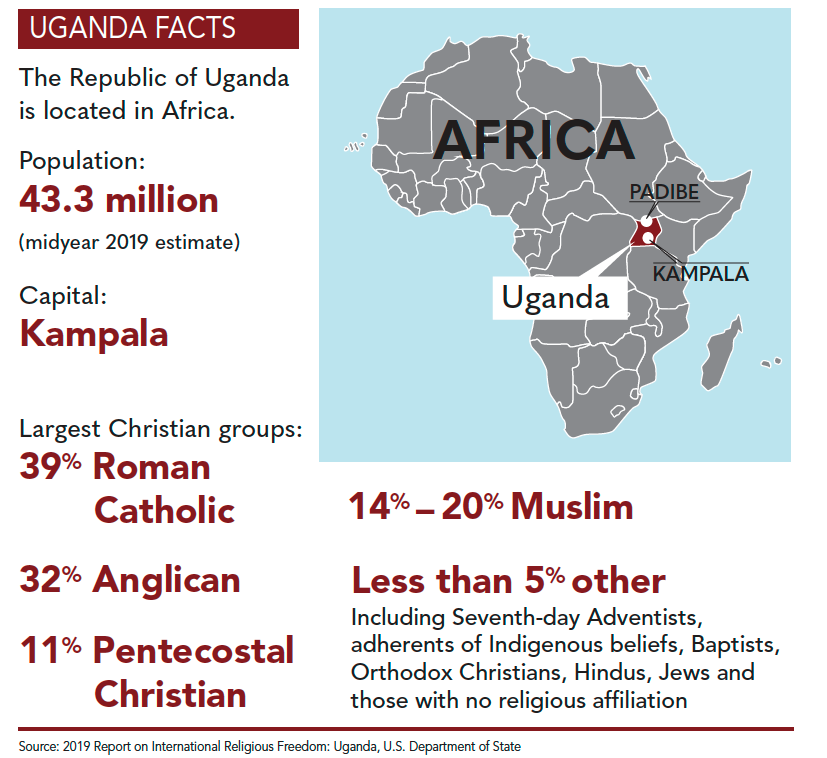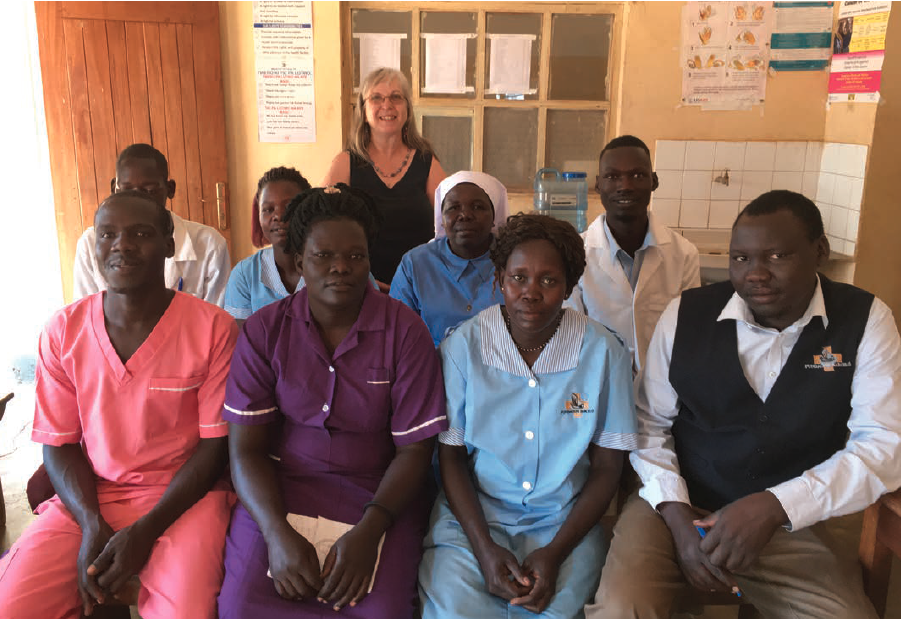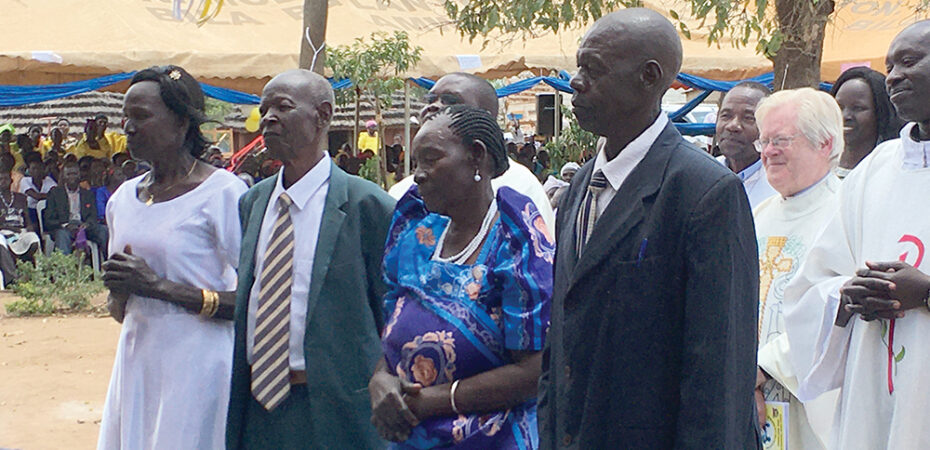Experiencing the Universal in the Universal Church
Doing mission work in Uganda
Deacon Gary Nosacek Comments Off on Experiencing the Universal in the Universal Church
We have all heard the term “universal Church.” Each Sunday, we profess in the creed, “one holy, catholic, apostolic Church” — the small “c” of “catholic” means universal. But, for most of us, Catholic Church usually means the local parish where we attend Mass. Maybe, if our bishop has some program or project that he is promoting, we will think in terms of our diocese, but that’s about as big as our “universe” gets.
My wife, Cindy, and I have always felt a connection to the worldwide nature of the Church, but she was a busy family-practice physician and I was doing a daily radio program. Then there were our five children that needed to be raised. Those things all stopped us from pursuing that calling. But then one day we noticed, the children were all grown, my radio station fired the entire staff due to a format change, and Cindy retired. We heard the Lord say, “Now will you answer the call?” We said a resounding “yes” and moved to our church’s sister parish, Mary the Immaculate, in Padibe, Uganda, for a month.
The Sameness
The parish priest, Father John Mark Oryem, wasted no time. He welcomed us to our new home and then promptly informed me with a big smile and hearty laugh that “daily Mass is at 7 a.m. and you are required.” After a pause, he said, “Tomorrow is in English.”
My first Mass there went off without a hitch. I found, much to my relief, that indeed the Church was universal, and it was no different than my Mass at Three Holy Women back in Milwaukee. The priest, however, couldn’t resist playing one little trick on me as a welcome to Uganda. As I poured the wine into the chalice, he kept saying, “A little more. Just a little more.” Then, when it came time to receive Communion, he dunked his host into the wine and said, “The rest is yours.” I imagined the stunned look on my face was priceless because he had the biggest grin on his face that I have ever seen. I drank the remaining wine and from that point on we became very good friends. I guess he decided that Deacon Munu (“the white deacon”) was an OK guy.

The next morning though, the universal part was put to a real test. I was again “required” to be at 7 a.m. Mass. As I vested, I was informed that the day’s Mass was in the Native language of the local Acholi Tribe, a language I had never even heard before, let alone understood. I had visions of being totally clueless and messing up everything. But as the Mass began, my fears completely disappeared.
After an opening prayer, Father John Mark pointed to me and I said, in English: “Lord, have mercy. Christ, have mercy. Lord, have mercy.” After what sounded a lot to me like the Our Father, Father again pointed to me and I said, “Let us offer each other a sign of peace.” Even though I didn’t understand the actual words, I was able to understand what was going on, and the prayers being said, because the Mass in Uganda is exactly the same as the Mass in the United States. The Padibe parishioners in turn understood what I was saying, even though some couldn’t speak English well, because the Mass in Milwaukee was exactly the same as the Mass in Uganda.
While the Mass stood up to the claim that the Church was universal, we soon found out that not everything else did. Uganda does not have permanent deacons. All deacons there are transitional and on the way to becoming priests.
Parishioners started approaching Father John Mark demanding to know why deacons in the United States can be married but Ugandan deacons can’t. Since this could be a minor scandal in the making, Father decided that he, Cindy and I would give a little infomercial at the Sunday Masses that explained the difference between the two types of deacons. The parishioners were quite interested and seemed satisfied with the answer.
A Mission Church
Another difference was the missionary nature of the Church in northern Uganda. Father John Mark has 45 parishes. Some are in buildings that we would, or could, identify as churches. Others have Masses celebrated in school classrooms. We even did a few in fields under trees. Because he has 45 parishes, he sometimes can visit some months or, due to COVID, even years apart.
I’ll never forget going to one Mass in a field in a parish that Father hadn’t been to for two years. In his typical, “Let’s have fun with the deacon” style, he asked if I would help him with the baptism. The baptism turned out to be 65 baptisms. After Mass, I mentioned that I was amazed by the number.
He said: “Can you imagine? It is like that quite often when I visit distant communities. People hunger for the sacraments, and they all come when they hear I am there.” He also said that having the deacon and doctor with him probably added to the crowd as everybody wanted to see “the whites.”

A few of the outlying communities still practice some of the old ways and mix them in with their Christianity. Cindy and I found ourselves unwittingly in the middle of that one day. Cindy had been teaching and assisting at the church-sponsored clinic that our parish, Three Holy Women, helped to build, and people were quite excited that Sister Gariella had the white doctor helping her! One of the young novices who was doing a rotation at the clinic asked if we wanted to go with her to a small village that was holding a healing prayer service for an ailing elder. She thought having both doctor and deacon come would bring great comfort to the village. We readily agreed.
We started on a road that was cement, then became gravel, then became dirt, and then was grass. At last, we burst through the grass and were at the village. As we got out of the jeep, the young novice said: “I forgot to mention. Either the elder is suffering from dementia, or he is possessed by the ancient demon Abila. We don’t know which one yet.”
My first reaction was: “Sister, it’s OK to forget to tell me what time dinner is tonight. It’s not okay to forget that I may be facing a demon!” My second thought was: “They don’t have permanent deacons here, and the archbishop has eagerly let me function as one. The last thing I want to do is overstep my bounds by being part of what could be considered an exorcism.”
Luckily, my wife quickly determined it was dementia, not Abila, that was causing the erratic behavior of the elder, so I was able to say a few prayers for healing and the village was satisfied. That didn’t, however, stop a few of the local “healers” who screamed and wailed and claimed to “see a shadowy figure walking in a nearby field.” Cindy and I quietly and carefully distanced ourselves from that.
As we were leaving the village, the committee that organized the healing service asked if I would be willing to bless the sleeping elders before I left. In my mind, I was thinking of old people who are in a coma-type state, and I told them I’d be honored to do that. As we were walking toward the hut that the elders were in, I noticed that the group of committee members was getting smaller and smaller. By the time we reached the door of the hut, it was just me and the head of the committee. He told me to go in. The hut was filled with incense that was coming out of a large cauldron over a fire in the middle of the hut.
I thought, “That can’t be doing the elders any good.” Then I realized that I didn’t see any elders. I called to the man who was still standing just outside the door and asked where the elders were. He told me behind the curtain. I pulled back the curtain and discovered a mattress with human bones on it.
The sleeping elders were not senior citizens in a coma-like state. They were dead ancestors. After overcoming the shock of so completely misunderstanding what I was being asked to do on behalf of the Church, the Holy Spirit must have jumped in, as I came up with a prayer and blessing out of nowhere. The villagers were touched and thrilled. They said goodbye to us by doing a traditional song and dance as we drove away.
Later that night, as Cindy, Father John Mark and I were relaxing in the rectory with Nile Beer, I recounted the adventure. I told Father John Mark, “We may be part of the same universal Church, but I never did that in Milwaukee!”
He replied: “Some things like Church teachings, the Mass and the love of the sacraments are the same. Others are different. We sing and dance and play drums during Mass. You play organs. Universal doesn’t mean that everything is exactly the same. You’ll just have to come back to learn more.”
Return Visits
Cindy and I have taken him up on that offer. We have made eight trips to Mary the Immaculate in Padibe. Due to her work at the medical clinic, the elders have given Cindy the name Adyero, which means, “the one who gives of herself.” They also presented her with tribal dresses to wear on special occasions.
Out of respect, most people just call me Deacon, although the elders and Father John Mark will sometimes call me Okot, “the one who brings rain.” It is an affectionate name given to me in memory of one of our visits that happened during a drought. Every village I visited got a soft gentle rain. Just the kind the farmers needed and wanted.
To commemorate that, I was given the name. I received tribal shirts that match Cindy’s, but the people also like it and feel honored when I wear clerics on special occasions. To solve that dilemma, I have become quite an expert in figuring out how to put Acholi garments over my gray Roman-collar shirt!
I still don’t speak Acholi, but I did manage to learn the deacon prayers said during the Mass. Even after all our visits, the congregation still laughs happily and applauds as I struggle through the words. They love that I am making the effort to pray with them in their own language.
It has been a real blessing to be able to experience the universal Church at this deep level. “One, holy, apostolic Church” are no longer just words said as part of the creed. They are a reality that Cindy and I have lived and been able to share with many folks throughout the United States.
I encourage anyone who has the opportunity to visit a parish in another country to seize it. It will give you an insight into the Church that you just can’t get in any other way. The Lord has told us, “Go make disciples of all nations.” The Church took that command seriously, and it is a beautiful thing to be part of!
DEACON GARY NOSACEK is a permanent deacon at Three Holy Women Parish in Milwaukee. He also serves as the Archdiocese of Milwaukee’s circus and rodeo minister. He and his wife, Dr. Cindy Jones-Nosacek, are missionaries in Uganda and Mexico.





